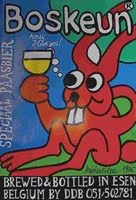Size: cask
ABV: 5.5 %
Stag parties tend to drink quicker than average; which in Belgium can be pretty dangerous. The poor Best Man will tend to hold the pocketful of age-weathered bank-notes and begrudgingly have to order a round of drinks every time the quickest drinker finishes his; and everybody else is too embarrassed to decline a drink so will continue to drink apace. In this case our quickest drinker was one of those more mature gentlemen who spends the majority of his time at the bar in England quaffing three or four pints of real ale every hour and never ever getting even slightly tipsy. This was very bad news.
We had only been in Les Brasseurs de la Grand Place for about eight minutes and we were already on to round two, which included the time it took to order from the bar. Table service seemed to have dried up at the moment the proprietors clocked it was a stag party, although from what I have heard about this place it could just as likely have been their customary incalcitrance. This brewpub is quickly having its reputation tarnished as an unfriendly tourist trap, which of course my party were not helping in any way with.
The location though is damned impressive; set literally just an inch off the Grand Place in Brussels. On a warmer day one can sit outside with a fag and a beer and watch one of Europes finest city squares go about its business. Today though it was cold, and we were all firmly indoors, which is also something of a pleasure. As soon as you enter Les Brasseurs you are immediately faced with the copper brew kettles on your left, from which seemingly miles of steel tubing wends away around the bar, upstairs, and into various atmospheric niches, nooks and crannies. The brewpub is set on three levels and the owners have done well to cram it all in so snugly. If you get bored tried to follow the maze of tubes with your eyes, then there is plenty of breweriana to explore.
Les Brasseurs de la Grand Place opened in the summer of 2001, and occupies a splendid looking building in the corner of the square. It was once a grocers, hardware store and even a concert hall, before finally ending up a famous coffee house in the 14th Century. It was only after a terrible fire in more recent times that the premises changed to one of Belgium’s most famous microbreweries. They continue to serve Brussels tourist fraternity by everyday drinking hours, and only somehow find the time to brew overnight when the public have finally been shoe-horned out the premises. It’s an expensive place to drink as you would expect, and they clearly make a lot of money given the daily throughput.
I recently read a comment about Les Brasseurs along the lines of “it could and should be so much more”, which is really quite painfully true. Here sits a microbrewery set in the very beating heart of a beer drinking capital which doesn’t seem to really take care of its customer. Les Brasseurs seem to have targeted their market at the average tourist, as opposed to any particular beer aficionado, and I feel their beer portfolio probably reflects this well. The Tripel was distinctive in its flavour but not particularly memorable. It was quite pale and a little flat, and I had hardly time to dwell on anything else before somebody was lining up my next one. Sigh

























